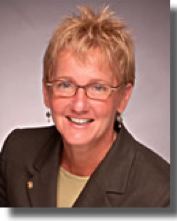
It was my pleasure to talk with Rosemarie Nelson after she had given her third presentation (!) at the North Carolina MGM Fall Meeting at Pinehurst this past October. As we visited, I realized I’ve been listening to Rosemarie talk about electronic medical records for at least 10 years. If you don’t know Rosemarie, she’s a running fanatic, an EMR guru, Principal Consultant with Medical Group Management Association (MGMA) and she has 15 years of consulting in operations and technology under her belt.
When I asked her why it’s so hard to implement electronic medical records in a physician’s office she said: “Medical practices are a home-grown industry, really a cottage industry, so every single one is different. There are specialty differences and workflow differences and many EMR vendors don’t know how to address this.”
Rosemarie particularly enjoys helping groups to fix poorly implemented systems and often finds that vendors have not carefully looked at the way the client physicians work before selling them a system. She has experienced the many unique ways that practices operate, and why they operate that way, and has been able to bring EMR success to over 300 practices during her tenure.
Rosemarie recommends that practices take electronic records a bite at a time. She suggests that groups start with one component, maybe ePrescribing, or messaging or electronic test results, and get it working really well. Although vendors might prefer that a group follow its timeline, there is no reason that a practice cannot set its own timeline. Finding out if a vendor will be flexible to a group’s unique needs and timeline is a must-have question when developing a RFP (Request for Proposal.)
The dichotomy of the physician (“make it so”) and the administrator (“take it slow”) is another challenge medical practices face. Many physicians want EMR to happen quickly and painlessly with no interruption of workflow. Rosemarie suggests to these physicians that they should “refer their business to a specialist (her), just as they would refer their patient to a specialist.” Working through the process takes time.
Here are some other observations from Rosemarie:
- “Apply the EMR as a tool to the operations, it is not an end to itself.”
- “Accept the incremental benefits” of the electronic medical record. “All or nothing is a losing propostition.”
- On the Stimulus Money for implementing EMR: “Do it because of the benefits and if you qualify for the stimulus, all the better.”
- On preparing an RFP (Request for Proposal): “Define the deliverables, the timeline and the money and focus on your practice’s absolute needs.”
- On scanning old paper records into the EMR, she says “Only 25% of documents stored are ever used again.”
- On savings using ePrescribing (besides the Medicare bump): “ePrescribing can save each FTE provider $15,000 per year on average.”
- On using electronics to make the medical practice more efficient, “A typical primary care practice might get 85-100 patient calls per day. Try to offload 30% of those calls per day to electronics – ePrescribing, patient secure messasging, electronic lab results, appointment requests, etc.”
- On her favorite client story: “A cardiologist who did not want to do ANYTHING differently, saw me two years later and told me that EMR was the best thing that had ever happened in his practice!”
- Her favorite tip: “Add your website address to your appointment reminder calls!”
- And…her most asked question ever – Tell Me Which EMR to Buy, to which she replies, “There really is more than one good product out there. Buy the one that matches your needs and your workflow the best, and it will be the right one for you!”
You can reach Rosemarie Nelson here: RosemarieNelson@alum.syracuse.edu

